
Preparing the transition to automated org charts using existing HR data sources
Automated OrgChart software helps get the job done faster, more accurately and in real-time.
The time taken to create useful, professional looking org charts has a real cost attached. Manually transferring data into a Visio, Word or PowerPoint document is a painstaking, error ridden process. Thankfully, modern org charting software can pull in data from various HR systems already being used frequently by an organization. Furthermore, by automatically pulling in source data, org charts are accurate in real-time and ready for an executive level presentation.
With access to employee data through a HRIS, payroll system or even Excel, org charts can be created automatically. To transition to an automated solution, consider the way data is stored and organized and the functionality of the software being considered. To help focus and prioritize all the necessary considerations for selecting the best adapted solution use the checklist below:
Large Data Sets – How many employees are there? Not all tools can handle very large data sets. Maximum capacity of the software should be carefully considered.
Excel (or CSV) file Import – Is any of the data housed in Excel Spreadsheets or CSV files? Does the software you use have a solution for these formats?
Direct Query – Allows for direct data import from HR systems. Negates the need to import static spreadsheets each time the chart is updated.
Dropbox – If direct query is not available, is there an FTP dropbox to push HR data?
Automatic Page Breaks – Charting hundred or even thousands of employees may require a chart be broken up into multiple pages.
Automatic Data Refresh – Allows chart updates by re-querying source data to reflect changes (e.g. supervisor changes, title changes, job exits). Gives the ability to update charts with a single click.
Scheduled Data Refresh – Automatically updates charts on a scheduled basis (e.g. daily, weekly, monthly.) Ensures org charts are never out of date, reducing the load on HR.
Employee Photos – If employee profile photos are desired can they be automatically updated upon data refresh of a chart?
Conditional Formatting – Can box formats be changed according to data driven rules? For example, vacant positions are automatically color coded for easy identification.
Manual Updates – Are manual updates allowed if needed (e.g. remove, add, update or move boxes)? Can accurate org charts be delivered even if there’s a backlog in updating the core HR data? For example, a new employee needs to be represented in the chart even if their official start date is in the future.
Establishing the current state of company data can help guide which software will provide the flexibility needed to create impactful automated org charts. Check out the OrgChart Now connector directory to identify the data sources you’re already using.
Creating and maintaining org charts instantly from existing HR data saves time and money. Start a free trial of OrgChart today, or schedule a demo with one of our experts, to find out how OrgChart Now can make valuable charts from a variety of HR data sources.
A solid understanding of the current state is key to deciding on the right tools to maintain and grow an organization. This document was developed to identify the key features and considerations to take into account to fully prepare for the selection and roll-out of a new org chart solution. With requirements clearly defined, an org chart software can be selected to best fit the needs of any business to grow and flourish.
